Tibetan Buddhism is the form of Buddhism practiced in Tibet where it is the dominant religion. It is also found in the regions surrounding the Himalayas, much of Chinese Central Asia, the Southern Siberian regions such as Tuva, as well as Mongolia.

The Kagyu, Kagyü, or Kagyud school, which translates to "Oral Lineage" or "Whispered Transmission" school, is one of the main schools of Himalayan or Tibetan Buddhism. The Kagyu lineages trace themselves back to the 11th century Indian Mahasiddhas Naropa, Maitripa and the yogini Niguma, via their student Marpa Lotsawa (1012–1097), who brought their teachings to Tibet. Marpa's student Milarepa was also an influential poet and teacher.
A tulku is a reincarnate custodian of a specific lineage of teachings in Tibetan Buddhism who is given empowerments and trained from a young age by students of his or her predecessor.
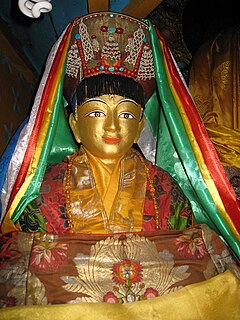
Jetsun Milarepa was a Tibetan siddha, who famously was a murderer as a young man then turned to Buddhism to become an accomplished buddha despite his past. He is generally considered as one of Tibet's most famous yogis and poets, serving as an example for the Buddhist life. He was a student of Marpa Lotsawa, and a major figure in the history of the Kagyu school of Tibetan Buddhism.
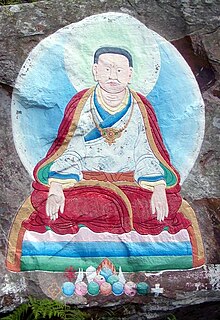
Marpa Lotsāwa, sometimes known fully as Marpa Chökyi Lodrö or commonly as Marpa the Translator, was a Tibetan Buddhist teacher credited with the transmission of many Vajrayana teachings from India, including the teachings and lineages of Mahamudra. Due to this the Kagyu lineage, which he founded, is often called Marpa Kagyu in his honour.

Gampopa "the man from Gampo" Sönam Rinchen was a Tibetan Buddhist teacher in the Kagyu lineage, as well as a doctor and tantric master who founded the Dagpo Kagyu school. He is also known as Dvagpopa, and the titles Dakpo Lharjé "the physician from Dakpo" and Daö Zhönnu, "Candraprabhakumara".

Tilopa (988–1069) was born in either Chativavo (Chittagong), Bengal or Jagora, Bengal in India. He was a tantric practitioner and mahasiddha. He practiced Anuttarayoga Tantra, a set of spiritual practices intended to accelerate the process of attaining Buddhahood. Naropa is considered his main student. At Pashupatinath temple premise, greatest Hindu shrine of Nepal, there are two caves where Tilopa attained Siddhi and initiated his disciple Naropa.

Nāropā or Abhayakirti was an Indian Buddhist Mahasiddha. He was the disciple of Tilopa and brother, or some sources say partner and pupil, of Niguma. As an Indian Mahasiddha, Naropa's instructions inform Vajrayana, particularly his six yogas of Naropa relevant to the completion stage of anuttarayogatantra.
The Six Dharmas of Nāropa, also called the Six Yogas of Nāropa, are a set of advanced Tibetan Buddhist tantric practices and a meditation sādhanā compiled in and around the time of the Indian monk and mystic Nāropa and conveyed to his student Marpa Lotsawa. The six dharmas were intended in part to help in the attainment of Buddhahood in an accelerated manner.
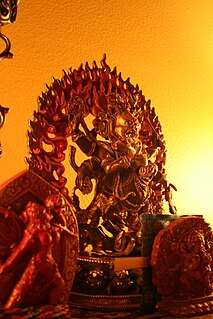
The Shangpa Kagyu is known as the "secret lineage" of the Kagyu school of Vajrayana or Tibetan Buddhism and differs in origin from the better known Dagpo schools. The Dagpo Kagyu are the lineage of Tilopa through his student Naropa while the Shangpa lineage descends from Tilopa's student Niguma, who was Naropa's sister, as well as from the teachings of Sukhasiddhi. Its founder was Khyungpo Neljor, the student of both women, whose monastery in the Shang Valley gave its name to the tradition.

Thubten Yeshe (1935–1984) was a Tibetan lama who, while exiled in Nepal, co-founded Kopan Monastery (1969) and the Foundation for the Preservation of the Mahayana Tradition (1975). He followed the Gelug tradition, and was considered unconventional in his teaching style.

Chagdud Tulku was a Tibetan teacher of the Nyingma school of Vajrayana Tibetan Buddhism. He was known and respected in the West for his teachings, his melodic chanting voice, his artistry as a sculptor and painter, and his skill as a physician. He acted as a spiritual guide for thousands of students worldwide. He was the sixteenth tülku of the Chagdud line.

Diamond Way Buddhism is a lay organization within the Karma Kagyu school of Tibetan Buddhism. The first Diamond Way Buddhist centre was founded in 1972 by Hannah and Ole Nydahl. It is led by Ole Nydahl under the spiritual guidance of Trinley Thaye Dorje, one of two claimants to the title of the 17th Karmapa. There are approximately 650 Diamond Way Buddhist centres worldwide.
Phowa is a Vajrayana Buddhist meditation practice. It may be described as "the practice of conscious dying", "transference of consciousness at the time of death", "mindstream transference", or “enlightenment without meditation”. "This controversial esoteric technique (Skt.utkrānti), by which a tantric practitioner is able to sever his connection to the physical body, goes by the Indian reference to 'yogic' or spiritual suicide. It is attested in many Saiva scriptures, in one Vaisnava Samhita, and a handful of Sākta Tantras. It appears to be of non-Buddhist origin."
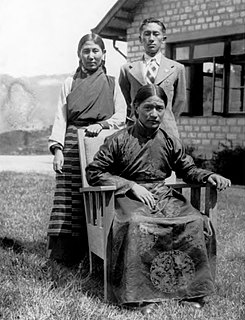
Dudjom Jigdral Yeshe Dorje, was the second Dudjom Rinpoche. He was recognized as a direct rebirth of Dudjom Lingpa (1835–1904) and was also later appointed the first supreme head of the Nyingma lineage of Tibetan Buddhism by the fourteenth Dalai Lama and the Central Tibetan Administration.
Zong Rinpoche was a Gelug Lama and disciple of the third Trijang Rinpoche, junior tutor of the 14th Dalai Lama. He was famous as a sharp analyst and master of philosophical debate, as well as a powerful Tantric practitioner. He was the Abbot of Ganden Shartse monastery.
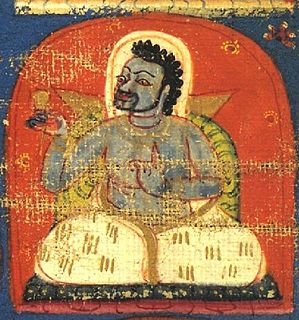
Dampa Sangye was a Buddhist mahasiddha of the Indian Tantra movement who transmitted many teachings based on both Sutrayana and Tantrayana to Buddhist practitioners in Tibet in the late 11th century. He travelled to Tibet more than five times. On his third trip from India to Tibet he met Machig Labdrön. Dampa Sangye appears in many of the lineages of Chöd and so in Tibet he is known as the Father of Chod, however perhaps his best known teaching is "the Pacification". This teaching became an element of the Mahamudra Chöd lineages founded by Machig Labdrön.

Kyabje Yongzin Ling Rinpoche is a Tibetan tulku. The best-known incarnation is the sixth incarnation, Thupten Lungtok Namgyal Thinley, a Tibetan buddhist scholar and teacher.
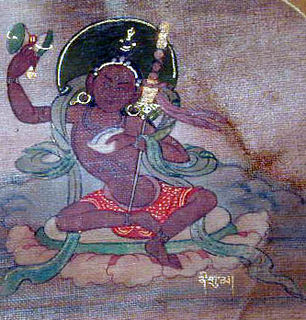
Niguma is considered one of the most important and influential yoginis and Vajrayana teachers of the 10th or 11th century in India. She was a dakini, and one of the two female founders of the Shangpa Kagyu school of Vajrayana Buddhism, along with dakini Sukhasiddhi. Her birth name was Shrijnana. Like many of the mahasiddhas and Tantric practitioners of the time, Niguma was known by several names both during her lifetime and afterwards. She was called Yogini Vimalashri, or Vajradhara Niguma, or Jñana (wisdom) Dakini Adorned with Bone (ornaments), or The Sister referring to her purported relationship to the great Buddhist teacher and adept Naropa. She was also sometimes called Nigupta, which is explained by the historical Buddhist scholar Taranatha as follows: "The name Nigu accords with the Indian language, which is Nigupta, and is said to mean 'truly secret' or 'truly hidden.' In fact, it is the code-language of the dakinis of timeless awareness."
Lama Chime Tulku Rinpoche is a Tibetan Buddhist, Tulku and Dharma teacher. Chime Rinpoche was born in 1941 in Kham, Tibet. In 1959, due to the occupation of Tibet, he was forced to flee to India via Bhutan into exile. Gaining British citizenship in 1965. He taught extensively throughout Europe and established Marpa House, the first Tibetan Buddhist Centre in England. His students include American author and Buddhist nun Pema Chödrön and musicians Mary Hopkin, David Bowie and Tony Visconti.













